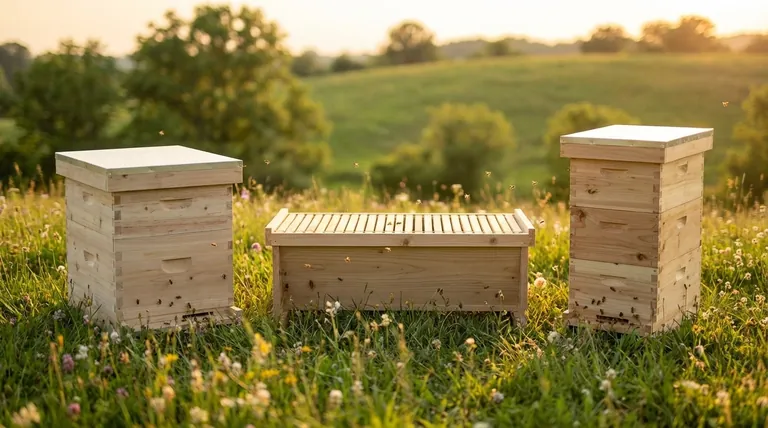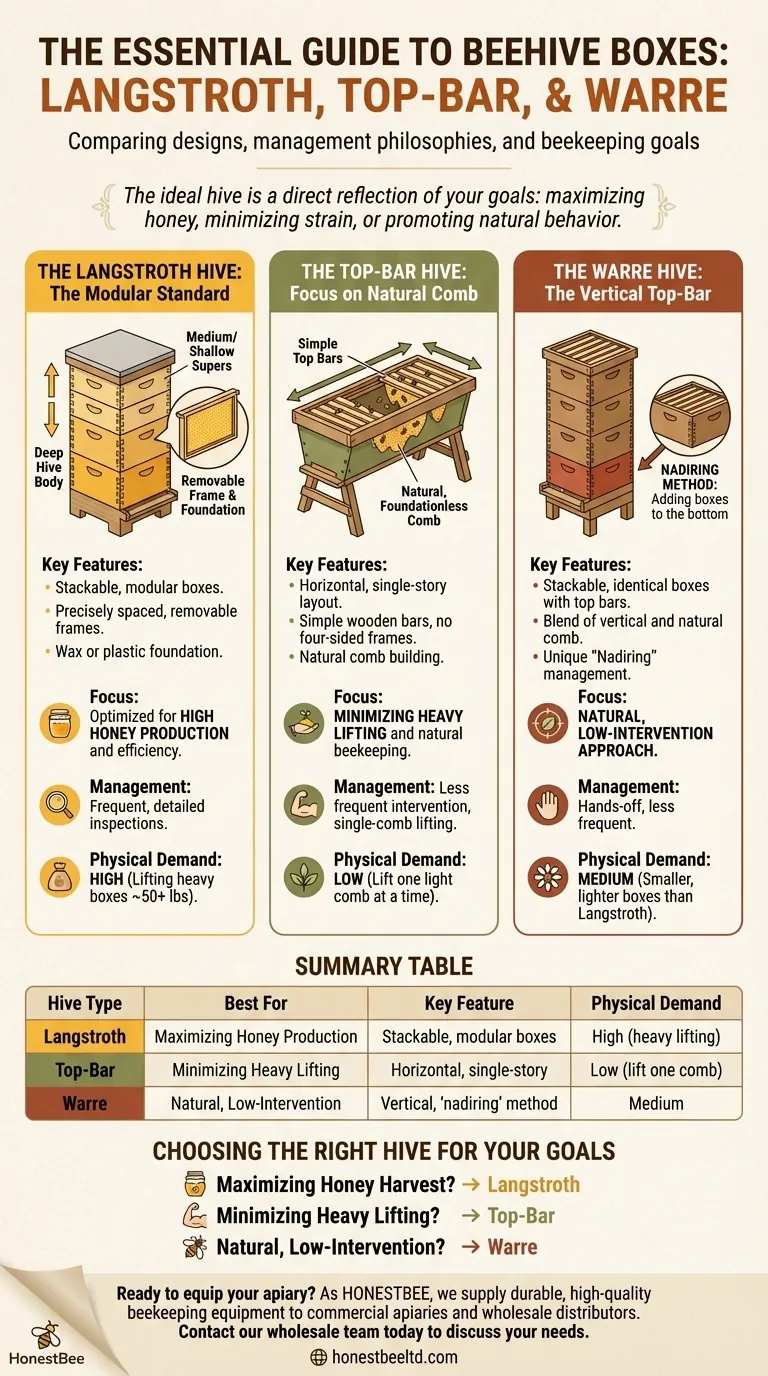The primary types of beehives are the Langstroth, Top-Bar, and Warre, with horizontal hives also being a common variation. Each design is built around a different philosophy of beekeeping, influencing everything from management style and physical effort to honey yield and the bees' natural behavior.
The "best" beehive doesn't exist; instead, the ideal choice is a direct reflection of your personal goals, be it maximizing honey production, minimizing physical strain, or promoting a more natural, low-intervention environment for the bees.

The Langstroth Hive: The Modular Standard
The Langstroth is the most recognizable and widely used beehive in the world, designed for efficiency and honey production. Its key innovation is the use of precisely spaced, removable frames.
Vertical, Stackable Design
The hive is composed of a series of stackable boxes, often called "supers." This modularity allows the hive to be expanded or contracted based on the colony's seasonal needs.
Larger boxes, called deep hive bodies, are typically used for the lower brood nest where the queen lays eggs and the colony raises its young. Smaller medium or shallow supers are stacked on top for honey storage and are harvested by the beekeeper.
The Role of Frames and Foundation
Each box holds a set of removable frames that guide the bees in building their comb. These frames can be fitted with a foundation, which is a sheet that provides a base for the bees to build on.
Foundations are typically made of either beeswax or plastic. Wax is more natural and encourages rapid comb building but is fragile. Plastic is far more durable and pest-resistant, though it often needs a coating of wax to entice the bees to use it.
The Top-Bar Hive: A Focus on Natural Comb
The Top-Bar hive is a single, long horizontal box. This design fundamentally changes the way a beekeeper interacts with the colony and is popular in natural beekeeping circles.
A Horizontal, Single-Story Layout
Instead of stacking heavy boxes, the beekeeper manages the hive by working from one end of the trough-like structure to the other. This completely eliminates the need for heavy lifting.
How Top Bars Work
The hive gets its name from the simple wooden bars that rest across the top. Bees build their comb naturally, drawing it down from these bars without the constraint of a four-sided frame or foundation. This allows them to build comb to the cell size they see fit.
The Warre Hive: The Vertical Top-Bar
The Warre (pronounced war-RAY) hive attempts to blend the vertical nature of a tree hollow with a hands-off management philosophy. It is often described as a vertical top-bar hive.
A Blend of Philosophies
Like a Langstroth, the Warre is a stackable, vertical hive made of identical boxes. However, like a Top-Bar hive, it uses simple bars at the top of each box to encourage bees to build natural, foundationless comb.
The "Nadiring" Method
Management is unique. Instead of adding new boxes (supers) to the top for honey, new boxes are added to the bottom of the stack. This technique, called nadiring, encourages the bees to move their nest downward as they would in a hollow tree, keeping the honey stores at the top for easy harvesting.
Understanding the Trade-offs
Choosing a hive is a commitment to a specific style of beekeeping. Each design comes with distinct advantages and disadvantages that cater to different priorities.
Management Intensity
The Langstroth design facilitates frequent and detailed hive inspections, which is standard in commercial operations. Warre and Top-Bar hives are designed for less frequent intervention, appealing to beekeepers who prefer to let the bees manage themselves more.
Honey Production vs. Natural Beekeeping
With its interchangeable frames and use of foundation, the Langstroth is optimized for high honey yields and efficient extraction. The foundationless comb of Top-Bar and Warre hives is more natural for the bees but results in lower, less predictable honey harvests.
Physical Demands
A Langstroth hive requires lifting heavy boxes that can weigh over 50 pounds. A Top-Bar hive only requires you to lift one comb at a time, making it an excellent choice for beekeepers with physical limitations. The Warre sits in the middle, as its boxes are smaller and lighter than a Langstroth's.
Choosing the Right Hive for Your Goals
Your beekeeping goals should be the primary factor in your decision. There is no wrong answer, only the right hive for you.
- If your primary focus is maximizing honey harvest: The Langstroth hive is the undisputed industry standard for its efficiency and production capacity.
- If your primary focus is minimizing heavy lifting: The Top-Bar hive's single-comb management style makes it the most physically accessible option.
- If your primary focus is a natural, low-intervention approach: The Warre and Top-Bar hives are both explicitly designed to support the bees' natural comb-building and colony behavior.
Ultimately, the best hive is the one that aligns with your philosophy and keeps you engaged and excited about the practice of beekeeping.
Summary Table:
| Hive Type | Best For | Key Feature | Physical Demand |
|---|---|---|---|
| Langstroth | Maximizing Honey Production | Stackable, modular boxes with frames | High (heavy lifting) |
| Top-Bar | Minimizing Heavy Lifting | Horizontal, single-story layout | Low (lift one comb) |
| Warre | Natural, Low-Intervention Approach | Vertical design with 'nadiring' method | Medium |
Ready to equip your apiary with the right hive system?
As HONESTBEE, we specialize in supplying durable, high-quality beekeeping supplies and equipment to commercial apiaries and distributors through wholesale operations. Whether you're scaling honey production with Langstroth hives or adopting a natural approach with Warre equipment, we provide the reliable tools you need for a thriving operation.
Contact our wholesale team today to discuss your specific needs and get a quote.
Visual Guide

Related Products
- Langstroth Bee Hives Bee Keeping Box for Beginners Beekeeping
- Long Langstroth Style Horizontal Top Bar Hive for Wholesale
- Wholesales Dadant Size Wooden Bee Hives for Beekeeping
- Professional Galvanized Hive Strap with Secure Locking Buckle for Beekeeping
- HONESTBEE Professional Long Handled Hive Tool with Precision Cutting Blade
People Also Ask
- What basic equipment is needed to start beekeeping? Your Essential Guide to a Confident Start
- Why were wooden hives traditionally preferred? For Natural Beekeeping Aligned with Bee Biology
- What are the key features of the Langstroth beehive? A Guide to the Standard for Modern Beekeeping
- What is the best type of bee hive for beginners? Start with the Proven Langstroth Standard
- Why are Langstroth hives recommended for beginners? Unmatched Support & Standardization



















